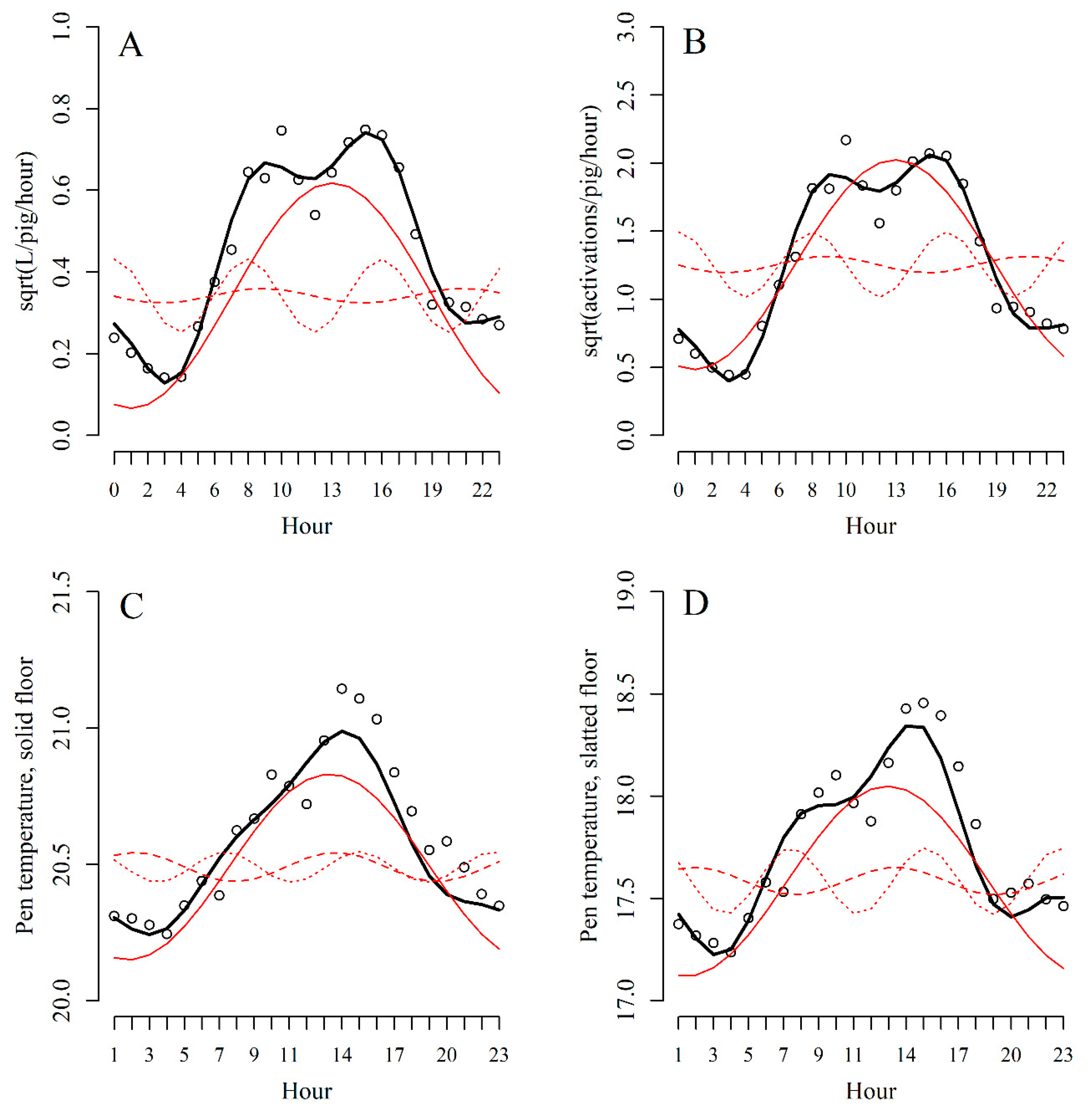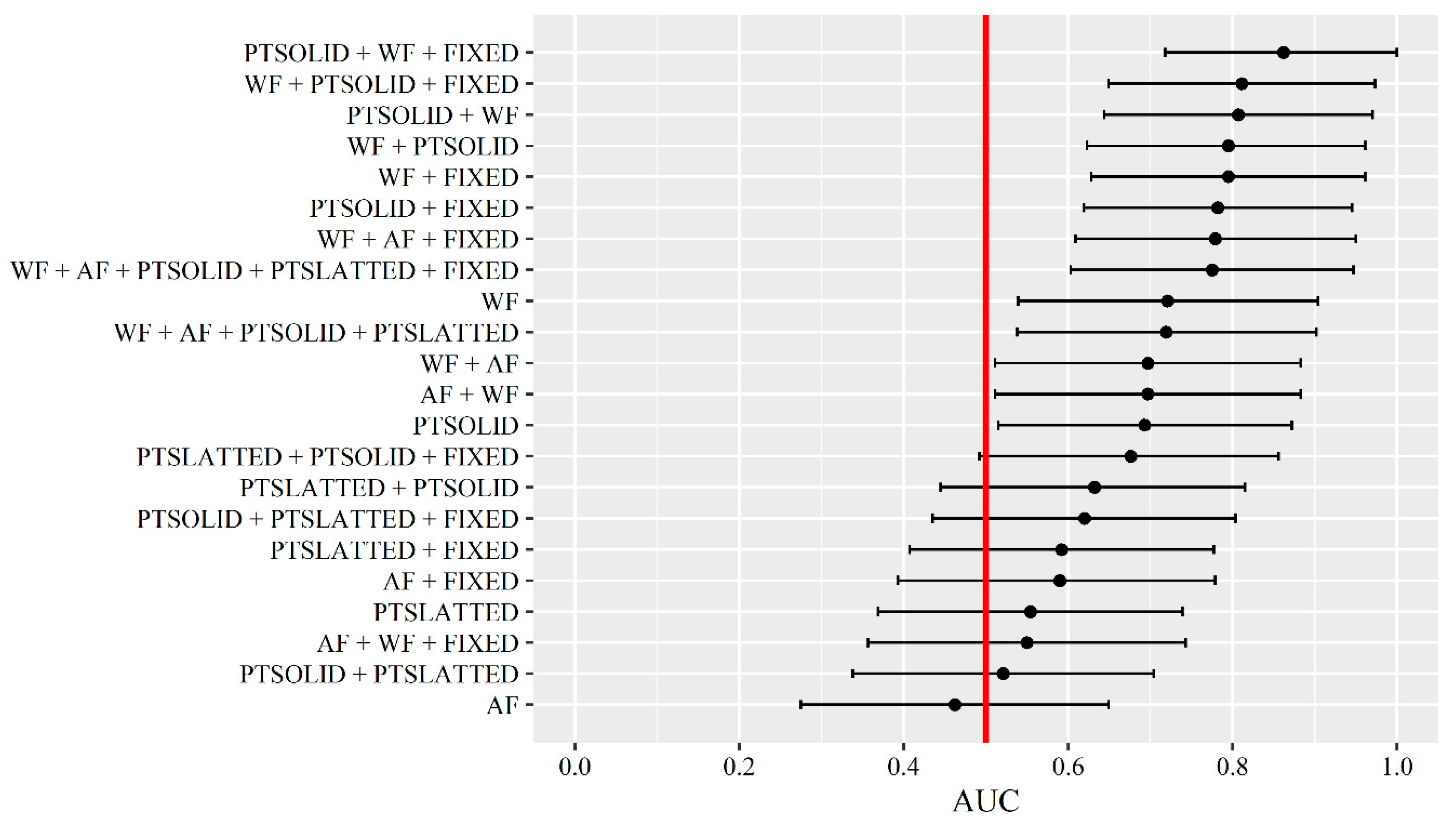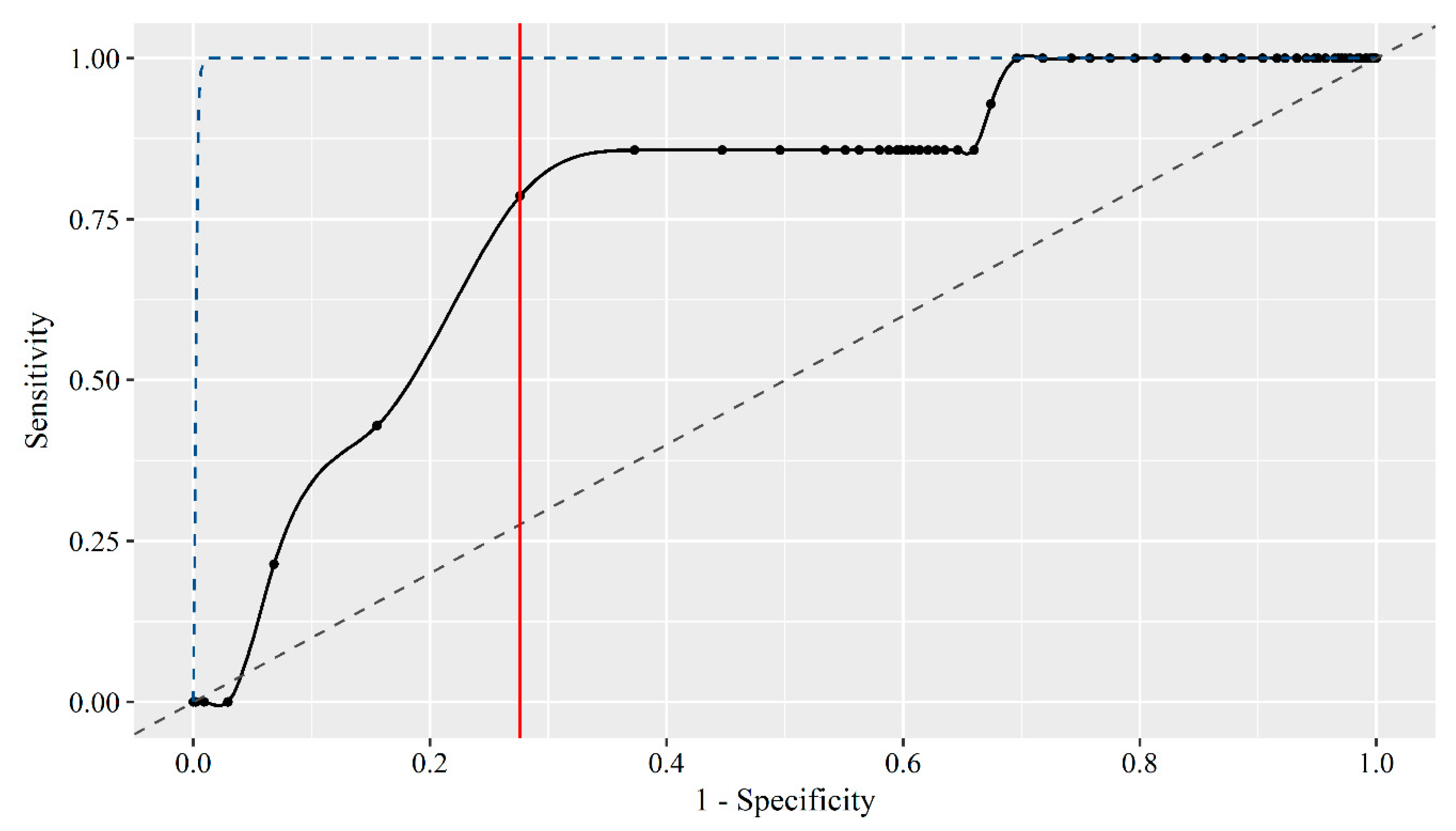Prediction of Tail Biting Events in Finisher Pigs from Automatically Recorded Sensor Data
Abstract
:Simple Summary
Abstract
1. Introduction
2. Materials and Methods
2.1. Data Sources
2.2. Modelling of Linear Trend and Diurnal Pattern to Obtain Forecast Errors
2.3. Development of The Prediction Algorithms
2.3.1. Evaluation Measures
2.3.2. Optimisation of Artificial Neural Networks
2.3.3. Performance Evaluation of the Artificial Neural Networks
2.3.4. Fixed Probability
2.3.5. Bayesian Ensemble
2.4. Real-Life Application
3. Results
3.1. Model Parameters
3.2. Performance of The Artificial Neural Networks
3.3. Performance of the Fixed Probability Model
3.4. Performance after the Bayesian Emsemble
3.5. Real-Life Application
4. Discussion
4.1. Which Data Sources to Include
4.2. Timing of Alarms
4.3. The Meaning of False Alarms
4.4. How to Improve the Prediction Algorithm
5. Conclusions
Supplementary Materials
Author Contributions
Funding
Acknowledgments
Conflicts of Interest
References
- Di Giminiani, P.; Edwards, S.A.; Malcolm, E.M.; Leach, M.C.; Herskin, M.S.; Sandercock, D.A. Characterization of short-and long-term mechanical sensitisation following surgical tail amputation in pigs. Sci. Rep. 2017, 7, 4827. [Google Scholar] [CrossRef] [PubMed]
- Sihvo, H.; Simola, O.; Munsterhjelm, C.; Syrjä, P. Systemic spread of infection in tail-bitten pigs. J. Comp. Pathol. 2012, 146, 73. [Google Scholar] [CrossRef]
- European Food Safety Authority. Scientific Opinion of the Panel on Animal Health and Welfare on a request from Commission on the risks associated with tail biting in pigs and possible means to reduce the need for tail docking considering the different housing and husbandry systems. EFSA J. 2007, 611, 1–13. [Google Scholar]
- Sinisalo, A.; Niemi, J.K.; Heinonen, M.; Valros, A. Tail biting and production performance in fattening pigs. Livest. Sci. 2012, 143, 220–225. [Google Scholar] [CrossRef]
- Kritas, S.K.; Morrison, R.B. Relationships between tail biting in pigs and disease lesions and condemnations at slaughter. Vet. Rec. 2007, 160, 149–152. [Google Scholar] [CrossRef] [PubMed]
- Valros, A.; Ahlström, S.; Rintala, H.; Häkkinen, T.; Saloniemi, H. The prevalence of tail damage in slaughter pigs in Finland and associations to carcass condemnations. Acta Agric. Scand. A Anim. Sci. 2004, 54, 213–219. [Google Scholar] [CrossRef]
- Larsen, M.L.V.; Andersen, H.M.-L.; Pedersen, L.J. Which is the most preventive measure against tail damage in finisher pigs: Tail docking, straw provision or lowered stocking density? Animal 2018, 12, 1260–1267. [Google Scholar] [CrossRef] [PubMed]
- Andersen, H.M.-L.; Jørgensen, E.; Pedersen, L.J. Using Evolutionary Operation technique to evaluate different management initiatives at herd level. Livest. Sci. 2016, 187, 109–113. [Google Scholar] [CrossRef]
- Villagrá, A.; Althaus, R.L.; Lainez, M.; Martinez, A.B.; Torres, A.G. Modelling of daily rhythms of behavioural patterns in growing pigs on two commercial farms. Biol. Rhythm Res. 2007, 38, 347–354. [Google Scholar] [CrossRef]
- Larsen, M.; Andersen, H.-L.; Pedersen, L. Changes in activity and object manipulation before tail damage in finisher pigs as an early detector of tail biting. Animal 2019, 13, 1037–1044. [Google Scholar] [CrossRef]
- Larsen, M.L.V.; Bertelsen, M.; Pedersen, L.J. Pen fouling in finisher pigs: Changes in the lying pattern and pen temperature prior to fouling. Front. Vet. Sci. 2019, 6, 118. [Google Scholar] [CrossRef] [PubMed]
- SJVFS. In Statens Jordbruksverks Föreskrifter och Allmänna Råd om Djurhållning Inom Lantbruket m.m. [The Swedish Board of Agriculture’s Regulations and General Recommendations on Animal Husbandry in Agriculture]; Case No L 100. Jönköping; Swedish Board of Agriculture: Jönköping, Sweden, 2010; Volume 15, Available online: http://www.jordbruksverket.se/download/18.7c1e1fce169bee5214faef7b/1553853097870/2019-014.pdf (accessed on 18 July 2019).
- R Core Team. R: A Language and Environment for Statistical Computing; R Foundation for Statistical Computing: Vienna, Austria, 2017; Available online: https://www.R-project.org/ (accessed on 18 July 2019).
- West, M.; Harrison, J. Bayesian Forecasting and Dynamic Models, 2nd ed.; Springer: New York, NY, USA, 1997. [Google Scholar]
- Madsen, T.N.; Andersen, S.; Kristensen, A.R. Modelling the drinking patterns of young pigs using a state space model. Comput. Electron. Agric. 2005, 48, 39–61. [Google Scholar] [CrossRef]
- Bates, D.; Maechler, M.; Bolker, B.; Walker, W. Fitting Linear Mixed-Effects Models Using lme4. J. Stat. Softw. 2015, 67, 1–48. [Google Scholar] [CrossRef]
- Ekstrøm, C.T. MESS: Miscellaneous Esoteric Statistical Scripts. R Package Version 0.5.5. MESS. 2019. Available online: https://CRAN.R-project.org/package=MESS (accessed on 18 July 2019).
- Jensen, D.B.; Toft, N.; Kristensen, A.R. A multivariate dynamic linear model for early warnings of diarrhea and pen fouling in slaughter pigs. Comput. Electron. Agric. 2017, 135, 51–62. [Google Scholar] [CrossRef] [Green Version]
- Jensen, D.B.; Larsen, M.L.V.; Pedersen, L.J. Predicting pen fouling in slaughter pigs from pig position and activity. Livest. Sci. under review.
- Dominiak, K.N.; Hindsborg, J.; Pedersen, L.J.; Kristensen, A.R. Area-specific predictions of unwanted events using multivariate modeling of water data. In Proceedings of the International Conference on Agro BigData and Decision Support Systems in Agriculture, Lleida, Spain, 12–14 July 2018. [Google Scholar]
- Jensen, D.B.; Kristensen, A.R. Temperature as a predictor of fouling and diarrhea in slaughter pigs. Livest. Sci. 2016, 183, 1–3. [Google Scholar] [CrossRef]
- Ostersen, T.; Cornou, C.; Kristensen, A.R. Detecting oestrus by monitoring sows’ visits to a boar. Comput. Electron. Agric. 2010, 74, 51–58. [Google Scholar] [CrossRef]
- Dominiak, K.N.; Hindsborg, J.; Pedersen, L.J.; Kristensen, A.R. Spatial modeling of pigs’ drinking patterns as an alarm reducing method II. Application of a multivariate dynamic linear model. Comput. Electron. Agric. 2019, 161, 79–91. [Google Scholar] [CrossRef]
- Noonan, G.J.; Rand, J.S.; Priest, J.; Ainscow, J.; Blackshaw, J.K. Behavioral observations of piglets undergoing tail docking, teeth clipping and ear notching. Appl. Anim. Behav. Sci. 1994, 39, 203–213. [Google Scholar] [CrossRef]
- Larsen, M.L.V.; Andersen, H.M.-L.; Pedersen, L.J. Tail posture as a detector of tail damage and an early detector of tail biting in finishing pigs. Appl. Anim. Behav. Sci. 2018, 209, 30–35. [Google Scholar] [CrossRef]
- Lahrmann, H.P.; Hansen, C.F.; D’Eath, R.; Busch, M.E.; Forkman, B. Tail posture predicts tail biting outbreaks at pen level in weaner pigs. Appl. Anim. Behav. Sci. 2018, 200, 29–35. [Google Scholar] [CrossRef]
- D’Eath, R.B.; Jack, M.; Futro, A.; Talbot, D.; Zhu, Q.; Barclay, D.; Baxter, E.M. Automatic early warning of tail biting in pigs: 3D cameras can detect lowered tail posture before an outbreak. PLoS ONE 2018, 13, e0194524. [Google Scholar] [CrossRef] [PubMed]




| Alarm Type A | Data Source | No. of Event Pens | No. of Control Pens | AUC B | 95% CI | Best Threshold C | Sensitivity D | Specificity D | Alarm Error Rate D |
|---|---|---|---|---|---|---|---|---|---|
| UNTIMED | Water flow | 11 | 50 | 0.721 | 0.539–0.904 | 0.57 | 0.818 | 0.580 | 0.700 |
| Activation frequency | 11 | 50 | 0.462 | 0.275–0.649 | 0.90 | 0.182 | 0.920 | 0.666 | |
| Pen temperature, solid | 12 | 54 | 0.693 | 0.515–0.872 | 0.77 | 0.667 | 0.722 | 0.652 | |
| Pen temperature, slatted | 12 | 54 | 0.554 | 0.369–0.739 | 0.45 | 0.917 | 0.241 | 0.788 | |
| BEFORE | Water flow | 11 | 50 | 0.525 | 0.334–0.717 | 0.64 | 0.455 | 0.700 | 0.750 |
| Activation frequency | 11 | 50 | 0.438 | 0.255–0.622 | 0.64 | 0.364 | 0.700 | 0.636 | |
| Pen temperature, solid | 12 | 54 | 0.581 | 0.396–0.766 | 0.68 | 0.750 | 0.519 | 0.743 | |
| Pen temperature, slatted | 12 | 54 | 0.444 | 0.268–0.620 | 0.83 | 0.167 | 0.907 | 0.714 | |
| ON | Water flow | 12 | 54 | 0.500 | 0.318–0.682 | 0.27 | 1.000 | 0.167 | 0.789 |
| Activation frequency | 12 | 54 | 0.510 | 0.327–0.692 | 0.85 | 0.333 | 0.833 | 0.692 | |
| Pen temperature, solid | 12 | 54 | 0.568 | 0.383–0.753 | 0.26 | 0.917 | 0.264 | 0.780 | |
| Pen temperature, slatted | 12 | 53 | 0.471 | 0.291–0.650 | 0.62 | 1.000 | 0.208 | 0.778 |
| TAIL | STRAW | SPACE | Week | |||||||||
|---|---|---|---|---|---|---|---|---|---|---|---|---|
| 1 | 2 | 3 | 4 | 5 | 6 | 7 | 8 | 9 | 10 | |||
| Docked | Yes | Low | 3.61 | 2.55 | 3.98 | 2.55 | 3.24 | 1.91 | 0.24 | 0.50 | 1.03 | 0.76 |
| High | 6.72 | 4.80 | 7.40 | 4.80 | 6.06 | 3.62 | 0.47 | 0.95 | 1.97 | 1.45 | ||
| No | Low | 9.38 | 6.76 | 10.29 | 6.76 | 8.48 | 5.11 | 0.67 | 1.36 | 2.80 | 2.07 | |
| High | 16.61 | 12.25 | 18.09 | 12.25 | 15.15 | 9.40 | 1.28 | 2.59 | 5.26 | 3.91 | ||
| Undocked | Yes | Low | 10.09 | 7.29 | 11.07 | 7.29 | 9.13 | 5.52 | 0.73 | 1.47 | 3.03 | 2.24 |
| High | 17.77 | 13.14 | 19.33 | 13.14 | 16.22 | 10.12 | 1.39 | 2.80 | 5.68 | 4.23 | ||
| No | Low | 23.68 | 17.85 | 25.60 | 17.85 | 21.75 | 13.91 | 1.98 | 3.97 | 7.95 | 5.96 | |
| High | 37.40 | 29.50 | 39.85 | 29.50 | 34.87 | 23.73 | 3.75 | 7.38 | 14.27 | 10.88 | ||
| Bayesian Ensemble Combination | No. of No-Event Days | AUC A | 95% CI | Best Threshold B | Sensitivity C | Specificity C | Alarm Error Rate C |
|---|---|---|---|---|---|---|---|
| WF | 2052 | 0.756 | 0.608–0.904 | 0.54 | 1.000 | 0.536 | 0.986 |
| PTSOLID | 2061 | 0.686 | 0.530–0.841 | 0.99 | 0.857 | 0.475 | 0.989 |
| WF + PTSOLID | 2031 | 0.762 | 0.615–0.909 | 0.67 | 1.000 | 0.535 | 0.985 |
| WF + FIXED | 2052 | 0.726 | 0.574–0.878 | 0.99 | 0.857 | 0.559 | 0.987 |
| WF + PTSOLID + FIXED | 2031 | 0.678 | 0.522–0.834 | 0.59 | 0.929 | 0.440 | 0.989 |
| WF + AF | 2052 | 0.761 | 0.614–0.908 | 0.66 | 0.857 | 0.692 | 0.981 |
| AF + WF | 2052 | 0.722 | 0.569–0.874 | 0.48 | 0.929 | 0.503 | 0.987 |
| WF + AF + FIXED | 2052 | 0.725 | 0.573–0.877 | 0.58 | 0.786 | 0.637 | 0.985 |
| PTSOLID + WF | 2031 | 0.726 | 0.574–0.878 | 0.99 | 0.857 | 0.559 | 0.987 |
| PTSOLID + FIXED | 2061 | 0.653 | 0.496–0.810 | 0.99 | 0.786 | 0.470 | 0.990 |
| PTSOLID + WF + FIXED | 2031 | 0.659 | 0.502–0.816 | 0.99 | 0.714 | 0.549 | 0.989 |
| WF + AF + PTSOLID + PTSLATTED | 2031 | 0.769 | 0.623–0.915 | 0.93 | 0.786 | 0.724 | 0.981 |
| WF + AF + PTSOLID + PTSLATTED + FIXED | 2031 | 0.726 | 0.575–0.878 | 0.90 | 0.786 | 0.635 | 0.985 |
| Bayesian Update Combination | Tail Biting | Fouling | Diarrhoea | ||||
|---|---|---|---|---|---|---|---|
| No-Event Day A | Day-3:Day-1 A | Day 0 A | Day + 1 A | Day-3:Day-1 A | Day-3:Day-1 A | ||
| WF | 937/2023 | (46%) | 14/14 | 8/14 | 8/15 | 25/35 | 13/16 |
| PTSOLID | 1065/2033 | (52%) | 12/14 | 8/14 | 8/14 | 22/35 | 14/16 |
| WF + PTSOLID | 1278/2003 | (64%) | 14/14 | 8/14 | 8/14 | 25/35 | 13/16 |
| WF + FIXED | 1150/2023 | (57%) | 13/14 | 9/14 | 12/15 | 24/35 | 12/16 |
| WF + PTSOLID + FIXED | 1117/2003 | (56%) | 13/14 | 8/14 | 12/14 | 24/35 | 13/16 |
| WF + AF | 622/2023 | (31%) | 12/14 | 6/14 | 4/15 | 25/35 | 10/16 |
| AF + WF | 1007/2023 | (50%) | 13/14 | 6/14 | 6/15 | 25/35 | 13/16 |
| WF + AF + FIXED | 734/2023 | (36%) | 11/14 | 6/14 | 5/15 | 17/35 | 11/16 |
| PTSOLID + WF | 883/2003 | (44%) | 12/14 | 7/14 | 9/14 | 25/35 | 13/16 |
| PTSOLID + FIXED | 1078/2033 | (53%) | 11/14 | 7/14 | 8/14 | 22/35 | 13/16 |
| PTSOLID + WF + FIXED | 901/2003 | (45%) | 10/14 | 7/14 | 7/14 | 17/35 | 11/16 |
| WF + AF + PTSOLID + PTSLATTED | 553/2003 | (28%) | 11/14 | 4/14 | 3/14 | 25/35 | 13/16 |
| WF + AF + PTSOLID + PTSLATTED + FIXED | 729/2003 | (36%) | 11/14 | 6/8 | 6/8 | 17/35 | 11/16 |
© 2019 by the authors. Licensee MDPI, Basel, Switzerland. This article is an open access article distributed under the terms and conditions of the Creative Commons Attribution (CC BY) license (http://creativecommons.org/licenses/by/4.0/).
Share and Cite
Larsen, M.L.V.; Pedersen, L.J.; Jensen, D.B. Prediction of Tail Biting Events in Finisher Pigs from Automatically Recorded Sensor Data. Animals 2019, 9, 458. https://doi.org/10.3390/ani9070458
Larsen MLV, Pedersen LJ, Jensen DB. Prediction of Tail Biting Events in Finisher Pigs from Automatically Recorded Sensor Data. Animals. 2019; 9(7):458. https://doi.org/10.3390/ani9070458
Chicago/Turabian StyleLarsen, Mona Lilian Vestbjerg, Lene Juul Pedersen, and Dan Børge Jensen. 2019. "Prediction of Tail Biting Events in Finisher Pigs from Automatically Recorded Sensor Data" Animals 9, no. 7: 458. https://doi.org/10.3390/ani9070458





